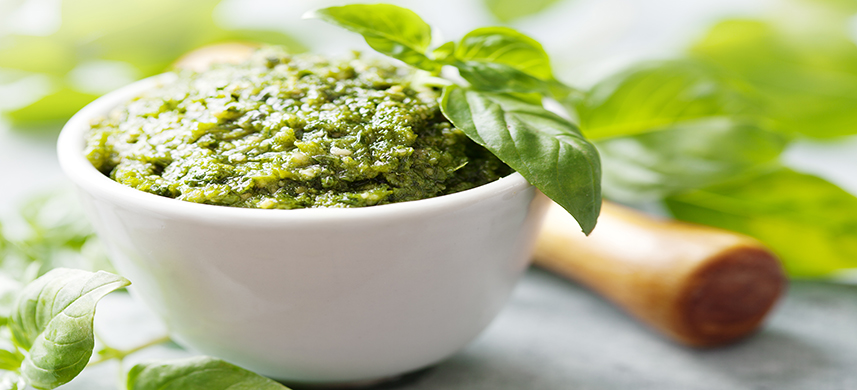Heartburn? We’ve got you covered
February 15, 2018

Pesto pasta plus tips to stop the burn
Rosemary Mueller, M.P.H., RDN, LDN, Clinical Dietitian at Northwest Community Healthcare Wellness Center
When it comes to eating pasta, most heartburn sufferers will avoid red sauce. Instead, you can substitute a creamy pesto sauce that’s super satisfying and well tolerated. Try this avocado pesto recipe and follow it up with our eating tips on how to stop the burn.
Avocado Pesto Recipe
This recipe was originally published in Eating Well, but altered to contain more protein and less fat. It’s also more GERD-friendly as hemp seeds and ground pepper were excluded.
Fat-controlled meal suggestion: Limit to a 2 Tbsp. portion. Toss with zucchini spirals, spaghetti squash, or whole-grain whole wheat or quinoa pasta. Optional add-in: cooked mushrooms. Pair with a small portion of grilled, broiled or baked fish, chicken or lean beef, cooked or roasted vegetable and fresh fruit to round out the meal. Avocado pesto also can be used as a mayo substitute in sandwiches.
Ingredients
- 1 large bunch fresh basil
- 2 ripe avocados
- ½ cup unsalted walnuts
- 2 Tbsp lemon juice
- 3 cloves garlic
- ½ tsp fine sea salt
- ½ cup extra-virgin olive oil
Preparation time: 10 minutes
Servings: 16
Instructions
- Remove fresh basil leaves from the stems and add to a food processor along with avocados, walnuts, lemon juice, garlic and salt; pulse until finely chopped.
- Add oil and process to form a thick paste. (Make ahead tip: Press a piece of plastic wrap directly on the surface to prevent browning and refrigerate for up to five days.)
Nutrition facts per 2 Tbsp serving:
Calories: 126; fat: 13g (2g sat); fiber: 2g; carbohydrates: 3g; protein: 1g; cholesterol: 0 mg; sugar: 0g; vitamin A: 236 IU; vitamin C: 4 mg; calcium: 14 mg; iron: 0 mg; sodium: 37 mg; potassium: 151 mg.
Tips on how to stop the burn
1) Avoid fat
- Avoid very high fat, greasy or fried foods and foods that don’t “agree” with your gut.
- Include foods higher in fiber for satiety, such as vegetables, whole grains and fruits.
2) Scale down portions
- The bigger the meal, the more likely the reflux.
- Go for quality over quantity. Eat a mixture of nutrient-dense foods, like vegetables, fruits, lean protein, low-fat dairy and healthy fats.
3) Drink water
- Water helps to dilute stomach acid.
- Try a small glass of water after meals. Avoid alcohol, carbonated beverages or beverages that contain caffeine or peppermint.
4) Slow down and stop
- Eating too fast can lead to overeating, which puts pressure on the lower esophageal sphincter muscle.
- Make it a habit to stop eating about 3 hours before bedtime.
Rosemary Mueller is a registered dietitian with NCH who provides nutrition consultations, lectures and other programming through the NCH Wellness Center.